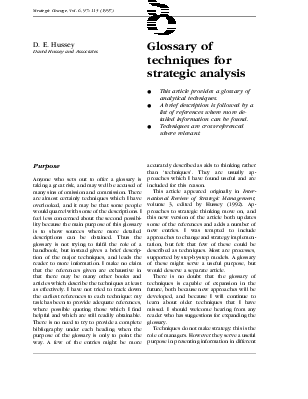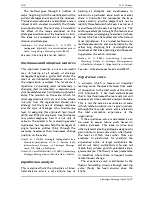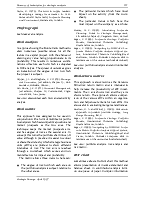


















Strategic Change, Vol. 6, 97±115 (1997)
D. E. Hussey
David Hussey and Associates
Glossary of techniques for strategic analysis
* This article provides a glossary of analytical techniques.
* A brief description is followed by a list of references where more detailed information can be found.
* Techniques are cross-referenced where relevant.

This article appeared originally in International Review of Strategic Management, volume 3, edited by Hussey (1992). Approaches to strategic thinking move on, and this new version of the article both updates some of the references and adds a number of new entries. I was tempted to include approaches to change and strategy implementation, but felt that few of these could be described as techniques. Most are processes, supported by step-by-step models. A glossary of these might serve a useful purpose, but would deserve a separate article.
There is no doubt that the glossary of techniques is capable of expansion in the future, both because new approaches will be developed, and because I will continue to learn about older techniques that I have missed. I should welcome hearing from any reader who has suggestions for expanding the glossary.
Techniques do not make strategy: this is the role of managers. However they serve a useful purpose in presenting information in different ways so that new insight can be gained. There is no one right technique for all occasions, and the analyst's ®rst task is to select approaches that are relevant and potentially helpful. My experience is that it is usually better to use two or three different techniques to let the information fall in different patterns, rather than to rely on only one. The analogy I like to use is that of a child's kaleidoscope. It is a number of pieces of coloured material in a glass-sided box, but each time the user moves the toy the pieces shift and a new pattern can be revealed. In analysis, the situation is not changed by the techniques, but the shaking up of the information brings out different pictures. And as every analyst knows, the application of a technique often reveals a need for information that has hitherto not been used in the organization.
![]()
Techniques do not make strategy
![]()
Techniques may also aid the presentation of complex issues, and may be seen as valuable communication devices, on top of the role of analysis. It often becomes possible to reduce many pages of narrative plan to one or two of the diagrams which result from the use of some of the techniques listed in this glossary. The ability to compress information, thus making it easier to reach a shared understanding on complicated situations is to my mind one of the most important justi®cations for using many of the approaches listed.
It is also worth stressing what most readers will already know: techniques do not implement strategy, and we should not think that the job is done when elegant analysis leads to strategic decisions. We still have to make those decisions work.
There is no restriction on the development of new techniques. Matrix displays can give great insight, and I frequently ®nd that using one approach sets me on the road to developing another that is original to the situation. The analyst should be willing to experiment. I also recommend using more than one technique when formulating strategy, because of the increased insight that this can give.
![]()
Techniques do not implement strategy
![]()
Уважаемый посетитель!
Чтобы распечатать файл, скачайте его (в формате Word).
Ссылка на скачивание - внизу страницы.